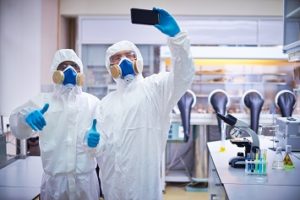It’s starting to look predictable: There were outbreaks of salmonellosis associated with microbiology laboratories in 2011, 2014, and 2017. The 2017 outbreak resulted in 24 illnesses and 6 hospitalizations in 16 states, from California to Maine, over a 3-month period. As a result of the outbreak, the Centers for Disease Control and Prevention (CDC) has issued an investigation notice urging individuals in microbiology laboratories to take appropriate precautions to prevent disease.
Whether your lab is in a clinical, commercial, or college and university setting, there are steps you can take to make your lab safer.
Working Safely with S. typhimurium
Faculty members who are in charge of microbiology laboratories can help to prevent outbreaks of salmonellosis by instituting protective measures that cover the entire hierarchy of controls, from elimination to personal protective equipment (PPE).
Elimination/Substitution. The CDC recommends that faculty members reduce or eliminate the exposure whenever possible by substituting nonpathogenic or attenuated bacterial strains, especially in teaching laboratories.
Engineering controls. In some cases, work with pathogenic agents should be performed inside ventilated biosafety cabinets. Pathogenic strains of S. typhimurium (the strain implicated in the 2011, 2014, and 2017 outbreaks) should be handled using biosafety level 2 procedures.
Administrative Controls. Policies, practices, and work rules that can help to prevent infection in laboratories include:
- Hand-washing. Those people working in a microbiological laboratory with infectious agents should wash their hands frequently, including before they leave the laboratory. Faculty members are responsible for ensuring that hand-washing sinks have soap and paper towels.
- Cleaning and decontamination. Any potentially contaminated surface in the laboratory should be thoroughly cleaned and decontaminated after work with infectious microorganisms.
- Personal items. Individuals should not bring personal items into a laboratory where infectious agents are present, including car keys and personal electronics. Items that are needed in the laboratory, like writing utensils and notebooks, should be provided for use only in the laboratory.
- Food and drink. No food or drink should be allowed in any laboratory where work is performed using infectious agents.
- Training. Any student or employee who will work with infectious agents must be informed of the hazards and trained in biosafety practices and techniques required for safe handling of pathogens. They should demonstrate proficiency before they are allowed to work in the laboratory. Workers should also recognize symptoms of infection, including diarrhea, fever, and abdominal cramps, and should seek medical attention if they or a family member develop symptoms.
PPE. While working with infectious agents in the laboratory, both students and staff should wear gloves and lab coats. Lab coats should not be removed from the laboratory, except to be cleaned by the institution. Employees who are working on an open bench with pathogenic S. typhimurium should wear face shields, eye protection, and respiratory protection.

